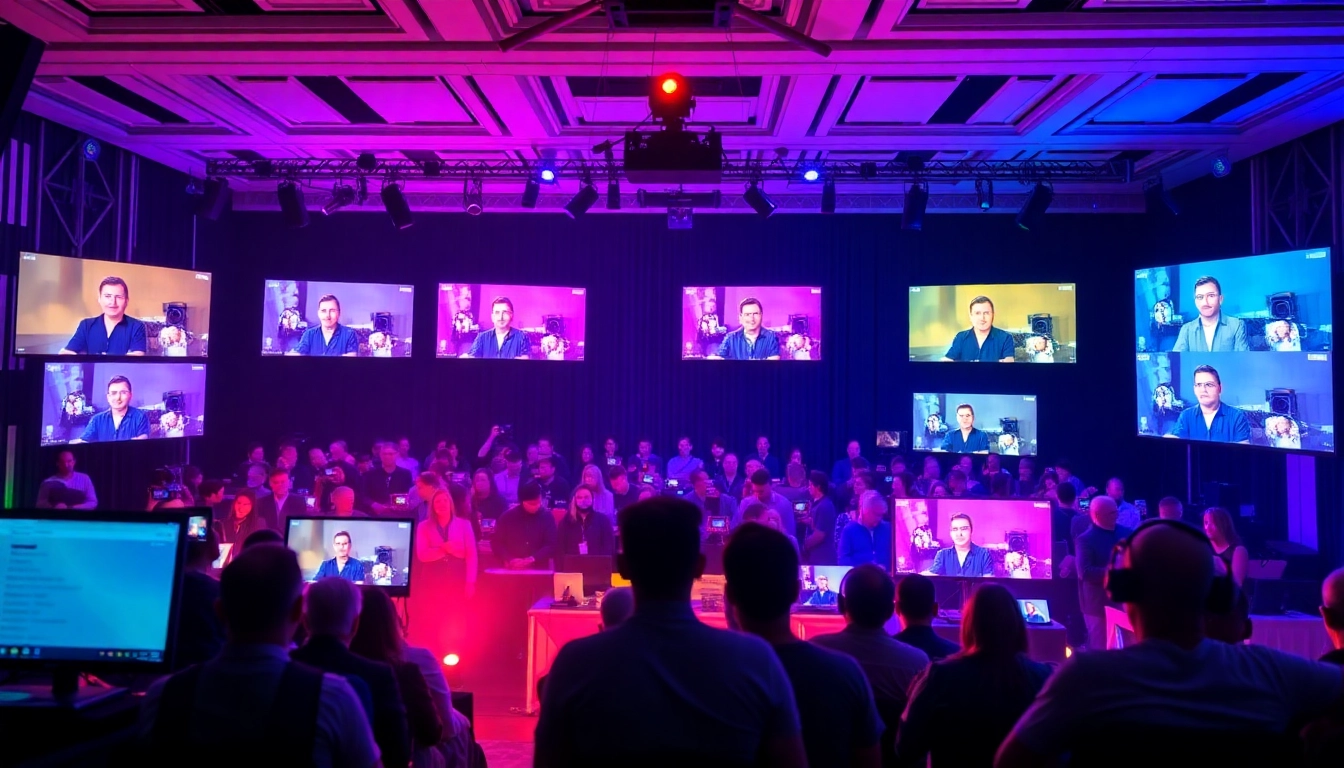Understanding the Virtual Audience System
What is a Virtual Audience System?
A Virtual Audience System (VAS) is an innovative platform designed for hosting interactive online events that engage participants in real-time, fostering a sense of community and interaction similar to that of a physical gathering. As digital communication becomes increasingly dominant, understanding how to utilize a VAS can significantly enhance the experience for both presenters and attendees. Whether it’s a conference, a webinar, or an online workshop, a well-implemented VAS integrates various technologies to create an immersive environment. With features like live streaming, chat, video conferencing, and interactive tools, this system allows for participation from audiences around the globe. As organizations continue to pivot from traditional in-person meetings to digital solutions, the relevance and utility of a Virtual Audience System cannot be overstated.
Benefits of Using a Virtual Audience System
The transition to a Virtual Audience System offers numerous benefits over traditional event formats:
- Broadened Accessibility: Virtual events can accommodate participants from various locations, breaking geographical barriers and allowing for a more diverse audience.
- Cost Efficiency: Hosting online events significantly reduces expenses associated with venue hire, catering, and travel, making it a more economical choice.
- Enhanced Engagement: A well-crafted VAS can foster higher levels of engagement through interactive tools such as polls, Q&A sessions, and chat features.
- Data and Analytics: Virtual platforms often come equipped with tools to track audience participation and engagement, providing valuable data that can inform future events.
- Flexibility and Convenience: Attendees can join from the comfort of their homes or offices, allowing for a more relaxed environment that can cater to different time zones.
Key Features to Look For
When selecting a Virtual Audience System, certain features can significantly enhance the user experience:
- Interactive Tools: Look for systems that offer live polls, surveys, and chat options to engage the audience actively.
- Seamless Streaming: High-resolution video and audio quality are paramount for maintaining engagement during presentations.
- Breakout Rooms: The ability to create smaller discussion groups allows for more in-depth conversations among participants.
- Customizable Interfaces: A tailored experience can make events feel more personal and relevant to the audience.
- Analytics Dashboard: A robust analytics tool is essential for tracking registration, attendance, engagement levels, and post-event feedback.
Implementing a Virtual Audience System
Steps to Set Up Your Virtual Audience System
Setting up a Virtual Audience System involves a series of strategic steps designed to ensure a smooth implementation:
- Identify Your Objectives: Determine what you intend to achieve with the event, whether it’s networking, education, or entertainment.
- Select the Right Platform: Research and choose a VAS that meets your needs based on the features discussed earlier.
- Design the Event: Create a detailed agenda and flow for the event, including scheduled presentations, breaks, and interactive sessions.
- Test the Technology: Prior to the event, conduct a dry run to ensure all technical aspects function smoothly.
- Promote the Event: Leverage social media, email newsletters, and partnerships to promote your virtual event and attract attendees.
Best Practices for Integration
Successful integration of a Virtual Audience System within existing processes can be optimized with the following best practices:
- Consistent Branding: Ensure visuals and messaging are cohesive across all platforms to strengthen brand identity.
- Engage Speakers Early: Involve presenters in the planning phase to craft content that resonates with the audience.
- Utilize Social Media: Create a buzz around your event by actively sharing updates and engaging with potential participants on social channels.
- Follow-Up Post-Event: Send out thank you notes, surveys, and links to recordings to maintain engagement and gather valuable feedback.
Tools and Technologies for Support
To optimize your Virtual Audience System, additional tools and technologies may be employed:
- Video Conferencing Software: Platforms like Zoom or Microsoft Teams can enhance attendee interaction.
- Marketing Automation Tools: Use platforms such as Mailchimp for promoting events and managing attendee communications.
- Content Management Systems: Systems like WordPress or HubSpot can help manage event websites and registrations efficiently.
Engagement Strategies for Virtual Events
Creating Interactive Experiences
Creating interactive experiences is pivotal in maintaining participant attention during virtual events. This can involve:
- Breakout Sessions: Use breakout rooms to facilitate small group discussions, providing more opportunities for networking and collaboration.
- Audience Challenges: Implement challenges related to the event theme that encourage participation and friendly competition among attendees.
- Real-Time Feedback: Encourage attendees to provide feedback in real-time during the event to adjust pacing and content accordingly.
Utilizing Polls and Q&A Sessions
Integrating polls and Q&A sessions can elevate engagement during presentations:
- Live Polling: Gauge audience understanding or opinions on certain topics through live polls, allowing presenters to tailor content dynamically.
- Dedicated Q&A Segments: Setting aside time for questions ensures audience doubts are addressed, which can enhance the overall experience.
Incorporating Gamification Elements
Gamification can transform a traditional event into a captivating experience through:
- Point Systems: Encourage attendees to earn points for participating in different activities, which can be redeemed for prizes or recognition.
- Leaderboards: Display top participants to create a competitive atmosphere and motivate others to engage more actively.
Measuring Success with a Virtual Audience System
Metrics to Track Engagement
To assess the effectiveness of your Virtual Audience System, focus on these key metrics:
- Attendance Rate: Measure the number of actual attendees versus registrations to evaluate interest.
- Engagement Rate: Track interactions (like chats, questions, and polls) to determine the level of audience involvement.
- Session Feedback Ratings: Collect ratings from participants on each session to identify strengths and areas for improvement.
Feedback and Improvement Strategies
Post-event feedback is crucial for continuous improvement. Implement strategies such as:
- Surveys: Deploy comprehensive surveys post-event to gather participant insights on both content and delivery.
- Follow-Up Interviews: Conduct interviews with select attendees to gain deeper insights into their experiences.
Case Studies of Successful Implementations
Examining successful case studies can provide valuable lessons for implementing a Virtual Audience System:
For instance, Company A hosted an annual conference using a VAS for the first time. By offering interactive features and engaging speakers, they increased participant satisfaction ratings by 40% compared to previous in-person events. Another success can be seen with Organization B, which leveraged gamification techniques resulting in a 50% boost in engagement metrics. Analyzing these examples can provide insights into effective strategies and common pitfalls to avoid.
Future Trends in Virtual Audience Systems
Emerging Technologies Shaping User Experiences
As technology continues to evolve, several emerging trends will shape the future of Virtual Audience Systems:
- Augmented Reality (AR): Incorporating AR can create immersive experiences that enhance audience engagement through virtual elements.
- 360-Degree Video: This technology allows participants to have a more interactive experience, giving them control over their view of the event.
- Virtual Reality (VR): VR platforms will allow users to attend events in a virtual environment, replicating the in-person experience on a significant scale.
The Role of AI in Enhancing Virtual Events
Artificial Intelligence (AI) is set to transform how audiences interact with virtual events:
- Personalized Content Delivery: AI can analyze attendee behavior and preferences to tailor content specifically to different audience segments.
- Chatbots for Engagement: AI-driven chatbots can facilitate real-time interactions, providing attendees with answers and support throughout the event.
Anticipating Changes in Audience Behavior
As virtual events become more prevalent, organizations must anticipate shifts in audience behavior:
- Expectations of Interactivity: Attendees may demand greater interaction and engagement, which necessitates ongoing innovation in virtual formats.
- Hybrid Event Models: The rise of hybrid events combining in-person and virtual elements reflects evolving participant preferences, necessitating versatile audience systems.


